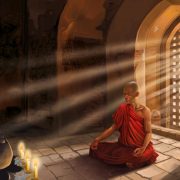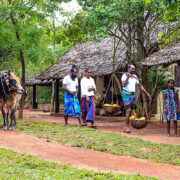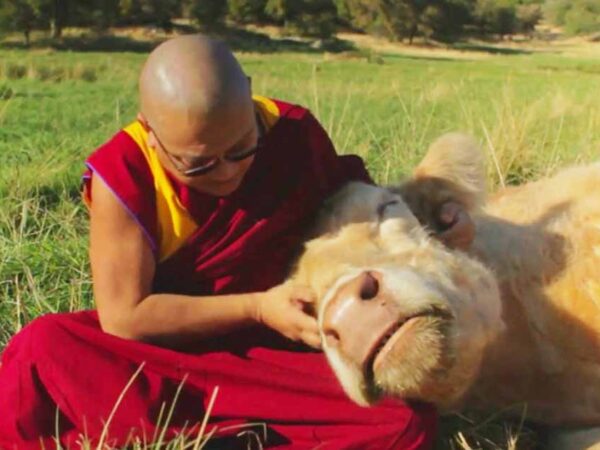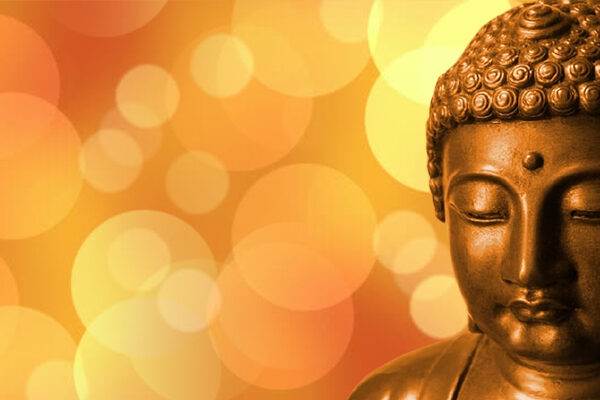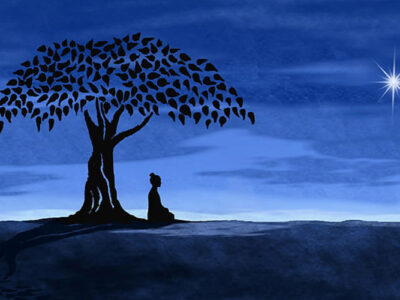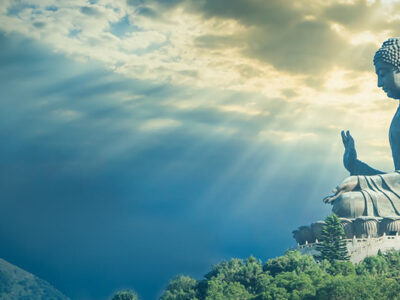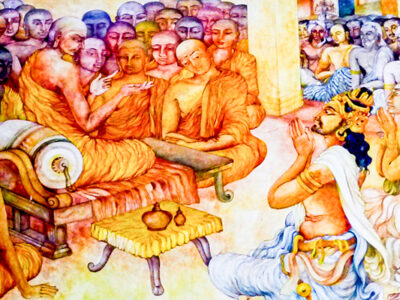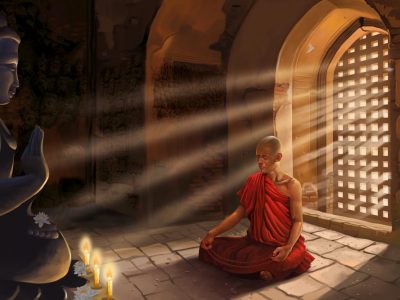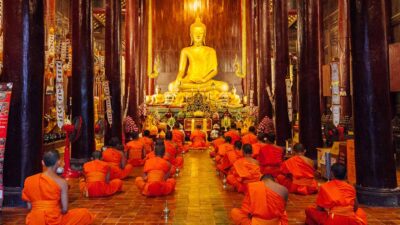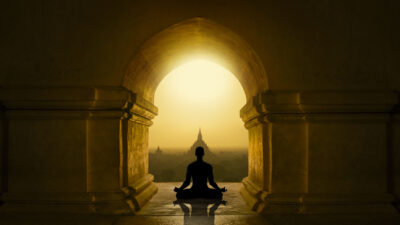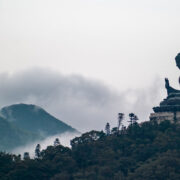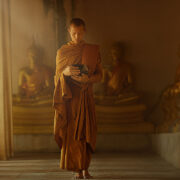By Vincent Panditha
Is death the end? This is a characteristic eschatological question. Dr. Leslie Weatherhead who asked the question recently, answered, “No, Death is not the end. Rather it is the beginning. I believe we all survive death, whether we’ve been good or bad, and that in the next class or phase we go morally and spiritually where we left off here. For me the evidence of survival is a convincing as scientific proof.” It is this conception of an after-life that confronts us with the moral problem. Continuity of life after death is a proved fact and Buddhism holds with the present theories that existence is a series of lives in a continuum. However, the origin of life and death we do not propose to go into, but it would be helpful to remember that the most popular theory is that death is the result of disobedience to the Divine Command. It was originally held that people were meant to live forever. The best known story for this is found in Gn. 3. Many other causes of the origin of death are given which are hardly of any purpose for our subject.
What we propose to discuss in this article is not so much the technicalities about the scientific theories of life and death, but mostly the popular conceptions about death, the dying person and his after-life and the rite and ceremonies conducted in such circumstances. Hardly any explanation has been given regarding the funeral rites of Ceylon (Buddhist) and hence here we venture to hazard a few conjectures which we hold quite liable to error. Wherever possible, the explanations are given mostly with reference to beliefs in other countries, which have been studied and explained by sociologists.
Death as well as life is an Act. Buddhism has set down a code of ethics which is the scientific theory for the guidance of the living; but no separate code has been put down as a theory for the guidance of the dying; and This is a quite explicable in the light of the fact that the conduct of this life is the code that guides the destiny of the dead. However, the technique of dying, which makes the dead enter happy future lives is, according to Buddhist theory, not so much the art of living the life, as the art of living the last few moments at death or rather the art of dying itself. Hence is it that the relatives of the dying man contrive various ways and means of keeping the dying man’s consciousness in a poor and sublime condition to gain for him a happy birth. To these contrivances we shall come later, but presently we may bear in mind that one’s next life depends on one’s present nature and aptitudes. Apart from the oriental point of view, even the Greek myths of the occident are based on this conception. For example, the sort of life chosen by each of the Greeks who preceded Odysseus is definitely symbolical of the character of the chooser.
Thus Orpheus, the greatest of harp players and the most enlightened of poets and singers, very appropriately chooses the life of a swan, for from time immemorial the swan has symbolized song and music. Likewise, Ajax, the Homeric hero, chooses the life of a lion. Atlanta famous for her footraces with her many suitors, is born as an athlete and finally the Jester Thersites becomes a monkey. Hence do the Greeks say “the good into the gentle and the evil into the savage, in all sorts of combinations,”
So death is a reality; and the after-life as well. Then the question is “How to accept death and die?” It is with this problem that we are concerned and it will be made clear within the course of the article that the rites and ceremonies on the part of the living are mostly concerned with the welfare of the dead and the safety of the living as well. Of course, it must be made clear at the very start that almost all the people of the East and the? West believe in a spirit that survived physical death, which escapes from the dead body and continues to exist. It is a strong belief of the Far-Eastern Buddhists as well, and hence countries like China, Japan and Tibet attune their rites and ceremonies to suit this conception. The Tibetans are the champions of this view and they believe in a Bardo State of forty-nine days (the maximum) when the spirit roams about till he is again reborn or gains final release. Even the Buddhists are not completely exempt from this kind of belief in spite of all Buddhist teaching and without this conception we find it difficult to explain a good many of the Buddhist rites and ceremonies conducted in Ceylon. These ceremonies attempt to send the spirit on the proper path and to prevent its ‘ghost’ from haunting the place of the living creatures.
Death is generally viewed with awe and fear. At the moment of death, empiric consciousness is supposed to be lost and there is what is popularly known as a swoon which is a corollary of the super-conscious itself. It is these few thought moments that are of great value in determining the future state of the “Soul complex.” Hence, as was referred to earlier, every attempt made by the wise in most countries, is to control or affect the consciousness of the dying. In Tibet, as the breathing is about to cease, instruction is given to the dying and the arteries are pressed to keep the dying person conscious with the consciousness rightly directed. Both in Catholic and Hindu ritual for the dying, there is constant prayer. The pressing of the arteries regulate the path to be taken by the outgoing vital current. The proper path, according to the Hindus is that which passes through the Brahmarandhra or the fissure on top of the cranium. This is a practice in the Solomon Islands even today.
The Buddhists of Ceylon summon the Buddhist theras at this moment and get pirith chanted or at other places, the Pinpota is read, in which are recorded the good deeds of the dying so that by listening to them the dying may generate happy thoughts and thereby qualify for a happy after-life. The Tibetans read, at this moment, their Book of the dead known as the Bardo Thodol which, is a “manual of religious therapeutic for the last moments and a psychurgy exorcising, instructing, consoling, and fortifying by the rites of the dying, him who is about to pass on to another life” Then again it describes the experience of the deceased during the intermediate period and instructs him in regard thereto. It is thus a traveller’s guide.
Just as the Pin-Pota is read or Pirit Chanted, the Bardo Thodol has to be read to the dying man in order to make the dying, face death fearlessly and mindfully. A specimen of the instructions given to the dying man is; “O nobly born, that which is called death hath now come. Thou art departing from this world, but thou art not the only one; (death) cometh to all. Do not cling in fondness to this life. Even though thou clingiest out of weakness, thou hast not the power to remain here. Thou wilt gain nothing more than wandering in this Sangsara. Be not attached to this world. Be not weak. Remember the precious Trinity.”
It is a strong belief amongst Ceylonese that the dying man sometimes experiences premonitory visions of the place of birth. King Dutugemunu according to the Mahawansa is said to have seen the heavenly cars that had arrived to convey him to the heavenly worlds. The Bardo Thodol too gives the Tibetan point of view when it instructs the dying man saying; “O nobly born now the signs and characteristics of the place of the birth will come. Recognize them. If to be born in the Eastern Continent of Lupha, a lake adorned with swans will be seen. Enter not that, for there is no religion there. If to be born in the Southern Continent of Jambu, grand delightful mansions will be seen….”
If one is to be born as a deva, delightful mansions built of various precious stone will be seen; if a an asura, circles of fire revolving in opposite directions, if as a beast, rock caves and deep holes. It is generally held in Tibet and Cambodia that if the dying is to be born a male he will have aversion to the father and attraction to the mother and if to be born a female, vice versa. Some see in these visions, the psychical resultants of the disintegrating process called Death.
The Theravadins theoretically cannot believe in an antarabhava or an interim haunting period of the dead, but most countries do firmly believe in it, and certain rites of Ceylon do point to such beliefs among this people, at least in their subconscious. The leaving of the dead body in complete silence and loneliness lets one disturb the spirit that is making an attempt to quit and the provision of food for the dead etc., point out to this belief, to which we shall come later. The nature of the existence during this Bardo period, according to the Tibetan, “is a prolonged dream-like state in what may be called the fourth dimension of space filled with hallucinatory visions, directly resultant from the mental contact of the percipient, happy and haven-like if the karma be bad.” The spirit in this Bardo state repeats his own past experiences and hence he hasn’t renounced his whisky and his cigars. During this Bardo state, the vision of the Clear Light appears as also the figures of the Buddhas Vairoccana, Vajrasatva, Amitabha, Amoghasiddhi etc., and if of course, due to the evil karma, he does not see them, he is reborn back in the world. If on the other hand, by a stroke of good luck, he recognizes them and considers everything as mere illusion he is realized. Thus, the esoteric significance of this Bardo is that the Divine Bodhi nature within one is tested. Full development leads to liberation.
The Christian idea of judgement is also to be found among the popular beliefs of the Ceylon Buddhists. They feel that especially when one goes to the Yamaloka (Hell) one’s deeds are weighted and judgement given. The idea of the heavenly messengers that come to remind man not to be indolent is found in the Devaduta Vagga of the Ang, Nik. The judgement scene as given in the Tibetan book is quite similar to that in the Egyptian book of the dead. Yamaraja is Dharmaraja in the Tibetan version, Osiris in the Egyptian and he sits as judge before whom white pebbles and back pebbles symbolizing good and evil deeds are weighed. The rest of the proceedings would be clear and need not be described.
Coming over to the ceremonial and ritual connected with dying and the dead, we here give a few of the customs of Ceylon and their parallels as found in other countries wherever possible. Herein, we cannot afford to forget the idea of the spirit of the dead, firstly because it is in the subconscious of the mind of the Ceylonese and secondly because without it, some of the customs of Ceylon appear inexplicable.
- Immediately after death, the body is, in certain part of the island, left in a room all alone, in perfect silence for some time. In Tibet, a white cloth is thrown over the face of the corpse and then no person touches the corpse in order not to interfere with the Bardo body. It may be the same idea in Ceylon to give full freedom to the supposed spirit of escape in peace, lest it might attempt harassing the living.
- In Ceylon, a pot of cooked rice is thrown out, in some areas, at least on the day corpse is removed by burial, if not other days as well. In Tibet, so long as the mourning continues, the spirit of the deceased is offered a part of all food of each meal. This food is placed in a bowl in front of the corpse and once the spirit has extracted the essence, the food is thrown away. Food continues to be offered up to the forty-ninth day of the Bardo. The Hindus offer a rice ball to the dead during the first night, before and after which, water for washing is poured out for him and he is invited by name. Milk and water are set out for him in the open air. The Shintoists of Japan bring meals at stated intervals. This custom is perhaps based on the kind of fiction kept up by the people that the spirit is alive and looks out for these offerings. The Shintoists are of opinion that the spirit continues to be in the body for some-time and hence the corpse is rolled from side to side to give it ease in lying, and conversation is kept up with it.
- To see the weal of the dead, the living makes it a point to perform the funeral ceremony in the best possible way. In Ceylon, drinks and cloths are offered to the monks at the ceremony in the name of the dead, no chanting is done apart from that of a single stanza on the nature of life. In Tibet, Lamas chant relays all day and night the service for assisting the spirit of the dead to reach Sukhavati.
- Ceylon Buddhists make it a point to have a Bana – preaching on the seventh day and a dana on following day or in a month’s time. The Tibetan parallel is that the Lamas who read the Bardo Thodol return to the house of the dead once a week until the forth-night day of the Bardo. The vastness of these sacrifices depends entirely on the richness of the relatives of the deceased. The idea here is perhaps to help the deceased by way of transferring merit as also to see that the living are safe from him.
- The dying man is, in Ceylon, made to rest in a comfortable position during his last moments and hardly any dabbling is done with him. But in Europe, a very widespread custom is to take a dying man out of the bed and to lay him on the earth or on straw. This is practiced from Ireland up to the Caspain Sea. A Brahamin of Malabar would be placed on a bed of kusa-grass in the verandah. Abb. Dieterich has endeavored to explain this as an attempt to bring the dying man in to touch with the earth so that the soul may pass without delay into the realm beneath. The main reason however appears to the prevention of the pollution of the bed.
- At the time of death, doors and windows are opened. This is done in Ceylon mainly to give more air and light to the dying who finds it difficult to breath and whose faculties are failing. But in France, Germany and Switzerland, it is not uncommon to take a tile off the roof. This is done with the object of easing the departure of the soul. Sometimes the return of the soul or spirit is feared. Hence the window is left open for a moment only. In China, a hole is made in the roof.
- It is a common practice in Ceylon to cover all mirrors, pictures etc. or to turn them with their faces to the wall. It is difficult to logically explain this custom of Ceylon, but since this is a custom common to other countries as well, it is to be conjectured, according to E.S. Hartland, that this was done to avoid puzzling and misleading the ghost in its efforts to quit the house. All water vessels are emptied or covered to prevent the ghost from drowning itself. It is probably because of this that the water standing in the vessels in the house are thrown away in order to avoid water that has been contaminated by the ghost.
- Wailing is a common sight in Ceylon. It has taken almost a ritual character, for women are hired for this purpose, in various parts of the island. The wailing frequently begins before death among the Hottentots who “set up such a terrible howling as were enough to freight the soul out of the body.” The main reason here may be excessive grief, but in primitive times, it has been practiced more in order to avoid suspicion of having been accessory to the death rather than to express grief.
- The present day washing of the corpse is a development of the primitive habit of painting it. This is done mainly to make it look clean. Eyes, if open, are covered with linen to prevent the eerie feeling in the survivors that they are being watched. Originally it was done to prevent the ghost from seeing.
Circumambulation is a rite performed in Ceylon today, in nothing but the correct way. The ceremony when correctly performed is the wailing round the corpse with one’s right-hand-side towards it. This is performed correctly when worshipping stupas etc. also when in a cremation the relatives who light the pyre, walk round it thrice. By the present practice of carrying the corpse thrice round the pit in case of burial, we honour not the dead but the pit. It is better to place the corpse over the pit and then walk thrice round it.


